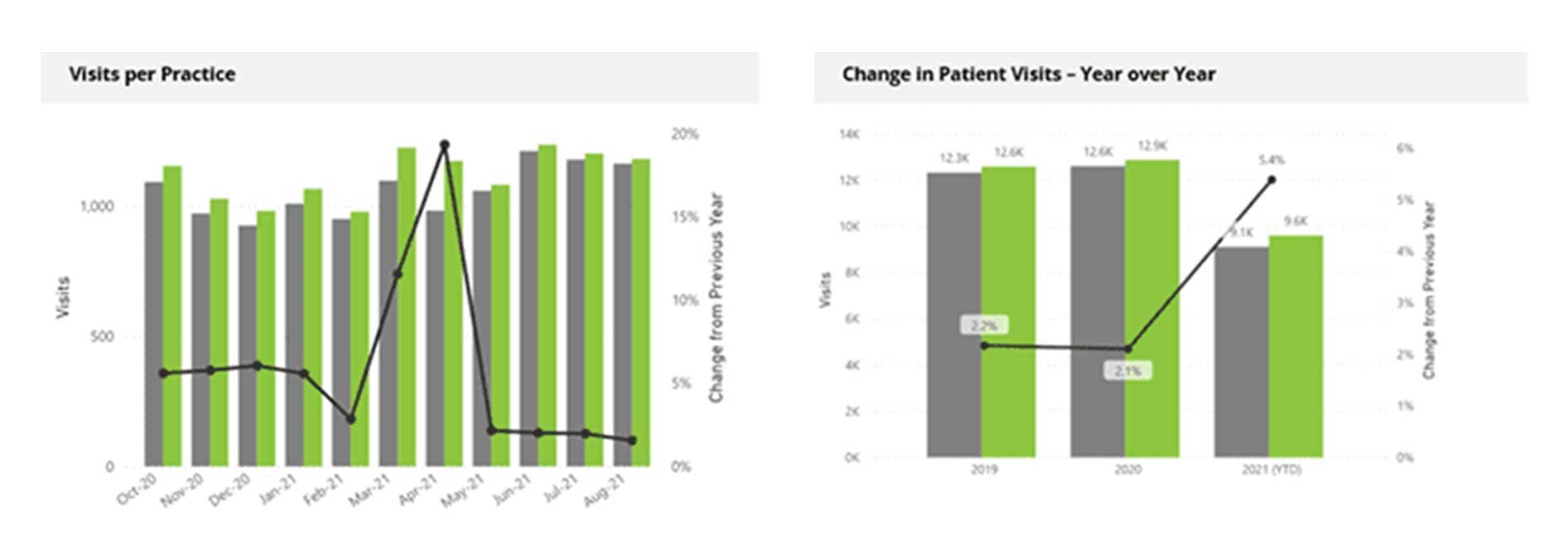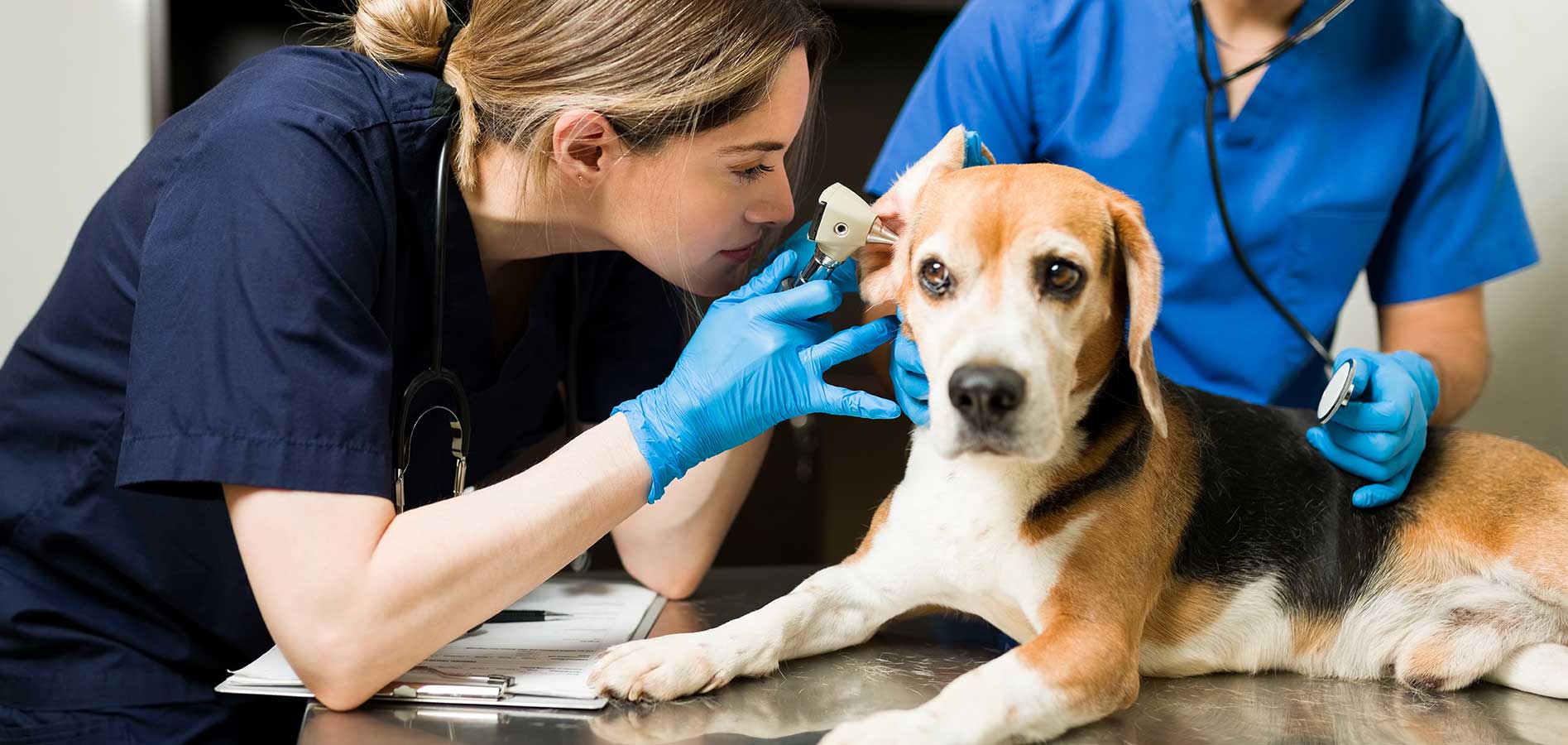VetSuccess data on this year’s emerging veterinary trends reaffirms the realities we are facing every day as veterinary professionals — too much to do, not enough staff, and practices that are busier than ever. On the surface, these findings aren’t surprising, but as with all data, there’s usually more to the story. By digging a little deeper into the numbers, we can:
- Identify current veterinary trends and challenges (these aren’t going away anytime soon).
- Gain insight into the complex factors that influence current industry challenges.
- Create tangible solutions to meet increasing demands in 2022 and beyond.
Comparing visits per practice in 2020 and 2021, and calculating the year-over-year percent changes, revealed that most practices weren’t actually that much busier from a typical yearly growth standpoint with an increase of about 2% to 5%.

Visits increased, but not by as much as you think
Does your practice seem to be overflowing with new veterinary clients? You’ll be surprised at who’s actually filling your exam rooms. Analyzing daily patients per doctor for 2019, 2020, and 2021 revealed that most practices saw about three extra patients in a four-day span this year. Of course, there’s much more at play here, and I’ll get to that, but it’s clear that more visits alone cannot account for the widespread veterinary burnout we are currently experiencing.
Existing clients drove the growth in visits
While the knee-jerk response to explain the increase in visits was once “pandemic puppies,” the numbers increasingly show that new pets were not the culprit. The data showed only ordinary growth in new patients per practice—about 3.5% year-over-year. Interestingly, practices did see an increase in active patients per practice—about 8% year-over-year. So there is an increase in veterinary appointments, but not from new clients.
Where did the increased visits come from?
- Existing patients — Existing clients brought previously seen pets in more often, and that drove growth more than visits from new pets (whether the client was new or not).
- Wellness visits — Practices saw a 5% to 7% increase in wellness visits, but only a 2% to 3% growth in sick visits.
The backlog of pet wellness visits from early in the pandemic when practices operated as essential businesses, treating only urgent cases, could explain the increase in these types of visits we’ve seen since restrictions have eased.

Veterinary appointments took longer
According to the data, appointments that took over an hour increased by 2% while appointments that took 20 minutes or less decreased by the same amount, meaning practices essentially swapped 2% of appointments from quick-and-easy to over-an-hour. There are several factors that explain the increased length of appointments:
- Decreased productivity — According to AVMA practice owner survey data from April and July 2020, productivity (the average number of patients per veterinarian per hour within a practice) was down almost 25%. And by the looks of things, practices have yet to return to post-pandemic levels of efficiency.
- Staffing shortages — Even a few extra patients can start to cause issues when you’re short-staffed. Now, when I see clients usually it is just me running the appointment, so I must be the history taker, the doctor, the phlebotomist, the technician who runs the tests, the customer service rep, the pharmacist, and the hand holder for the clients—many hats with extraordinarily little help.
- New protocols — Practices have had to adopt many new time-consuming protocols since the pandemic, and this can interrupt a practice’s workflow efficiency.
The substantial decrease in productivity and simultaneous increase in veterinary appointments presented by the data helps tell a more comprehensive story of current veterinary workforce challenges.

Clients increased their spending
Despite ongoing challenges, practices’ year-over-year growth in revenue increased from 6.7% in 2019 to about 10% in 2020 and 13.5% so far in 2021.
Who were the biggest spenders?
Clients spent more per veterinary visit than in prior years, and—you guessed it—existing clients spent the most. Revenue increases stemmed from the following areas:
- Appointment line items — The number of line items per visit increased this year, meaning clients were asking for more veterinary products and services.
- Higher-value products and services — More clients prioritized higher quality products and services over price.
- Average price increases — Prices increase by about 4% yearly, but increases in price made only a small contribution to practice revenue growth overall.
Looking at the numbers, it’s clear that veterinary professionals are still struggling. To ease the increasing burden of over-worked, thinly spread staff, practices must implement data-driven strategies that directly address the issues outlined in the data.
3 strategies for a more efficient 2022 and beyond
The issues facing our industry aren’t going away anytime soon, and practices need solution-oriented strategies they can use now. Here are three ways to navigate challenges in the year ahead:
1: Put your team first
- Prioritize wellbeing — Commit to creating an inclusive, healthy workplace that nurtures individual and workplace wellbeing.
- Recognize limits and set boundaries — Understand that you can’t do it all, and that’s OK. Support staff longevity by avoiding scheduling more than the team can handle.

2: Nurture client relationships
- Cultivate client loyalty — The data reveals that it is your existing clients who drive increased revenue. Recognize their value by creating a loyalty rewards program. Reward for dollars spent, referrals, online reviews, or any other behavior you want to drive.
- Take note of the little things — Remember the little things about your patients by being a good note keeper. Creating a personalized client experience is one of the most effective ways to cultivate customer loyalty, stand out, and show clients you care.
3: Leverage technology
- Utilize telemedicine — There is certainly an art to deploying and maintaining a full telemedicine platform, but even simply connecting with clients before their appointment can streamline your practice’s in-hospital itinerary and let doctors know what to expect before a patient comes in. That way, when a patient arrives for their appointment, the team can get right to work, saving valuable time.
- Streamline workflow with a veterinary practice app — A veterinary practice app can increase efficiency and improve client communication. My practice uses Vet2Pet’s robust platform, which offers:
- Online appointment scheduling
- Automated reminders
- Food and medication requests
- Telemedicine and teletriage services
- Chat, text, and email messaging
- Virtual payment
- And more
- Consider a remote employee — A remote employee like a digital coordinator can help with a variety of tasks, shouldering the workload and reducing stress for your in-practice team, while dramatically improving efficiency and client service. Potential tasks for a remote employee include:
- Managing appointment requests and confirmations
- Ordering inventory and managing refill requests
- Triaging patient cases
- Making follow-up calls
- And more
New year, new mindset
You may be looking at the new year with apprehension, but I encourage you to reflect on the past year’s challenges as well as accomplishments and make time to care for yourself over the holidays. Schedule a Vet2Pet demo to learn how the platform can streamline your team’s workflow, and welcome the new year refreshed and ready to embrace the one constant in our professional (and personal) lives—change.



